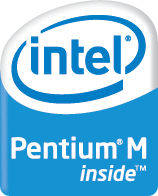Pentium M
 |
|
| Produced | From March 12, 2003 to August 8, 2008 |
|---|---|
| Common manufacturer(s) |
|
| Max. CPU clock rate | 900 MHz to 2.26 GHz |
| FSB speeds | 400 MT/s to 533 MT/s |
| Min. feature size | 0.13µm to 90nm |
| Instruction set | MMX, SSE, SSE2 |
| Microarchitecture | P6 variant |
| Cores | 1 |
| Socket(s) | |
| Successor | Intel Core |
| Core name(s) |
|
The Pentium M is a family of mobile 32-bit single-core x86 microprocessors (with the modified Intel P6 microarchitecture) introduced in March 2003 and forming a part of the Intel Carmel notebook platform under the then new Centrino brand. The Pentium M processors had a maximum thermal design power (TDP) of 5–27 W depending on the model, and were intended for use in laptops (thus the "M" suffix standing for mobile). They evolved from the core of the last Pentium III–branded CPU by adding the front-side bus (FSB) interface of Pentium 4, an improved instruction decoding and issuing front end, improved branch prediction, SSE2 support, and a much larger cache. The first Pentium M–branded CPU, code-named Banias, was followed by Dothan. The Pentium M-branded processors were succeeded by the Core-branded dual-core mobile Yonah CPU with a modified microarchitecture.
The Pentium M represented a new and radical departure for Intel, as it was not a low-power version of the desktop-oriented Pentium 4, but instead a heavily modified version of the Pentium III Tualatin design (itself based on the Pentium II core design, which in turn had been a heavily improved evolution of the Pentium Pro). It is optimized for power efficiency, a vital characteristic for extending notebook computer battery life. Running with very low average power consumption and much lower heat output than desktop processors, the Pentium M runs at a lower clock speed than the laptop version of the Pentium 4 (The Pentium 4-Mobile, or P4-M), but with similar performance - a 1.6 GHz Pentium M can typically attain or even surpass the performance of a 2.4 GHz Pentium 4-M. The Pentium M 740 has been tested to perform up to approximately 7,400 MIPS and 3.9 GFLOPS (using SSE2).
...
Wikipedia
